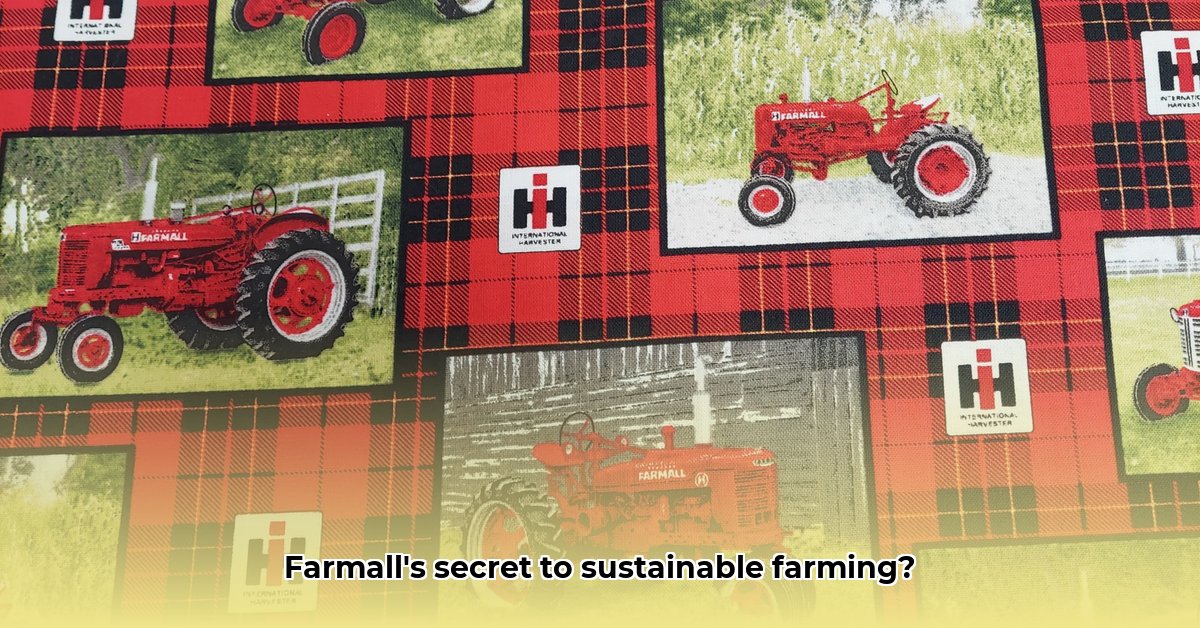
Farming demands resilience, and your Farmall tractor is a cornerstone of your operation. But beyond its power and performance, consider the environmental footprint of its construction. This guide explores the materials used in Farmall tractors, their sustainability implications, and actionable steps you can take to minimize your impact while maximizing your tractor's lifespan. We'll delve into responsible maintenance, disposal, and material selection, empowering you to cultivate a more sustainable future. For sustainable fuel options, check out this resource.
Understanding Farmall Tractor Materials: A Sustainability Deep Dive
Your Farmall tractor isn't just steel and rubber; it's a complex system of materials, each with its own environmental story. Let's examine the key components and their impact:
Steel: The Foundation of Strength
Steel forms the backbone of your Farmall, comprising the chassis, engine block, and countless other essential parts. While steel is undeniably robust, its production is energy-intensive, contributing to greenhouse gas emissions. However, the industry is evolving. The use of recycled steel significantly reduces the carbon footprint compared to using virgin materials. Furthermore, research into "green steel" production methods, aiming to minimize carbon emissions during the manufacturing process, is actively progressing. Choosing tractors built with a high percentage of recycled steel is a proactive step towards minimizing your environmental footprint. How much recycled steel is used in your next Farmall purchase? This is a crucial question to ask your dealer.
Rubber: Ensuring Traction and Resilience
Rubber, vital for tires and seals, plays a critical role in your tractor's performance. Traditional rubber production, however, often involves environmentally taxing processes that impact biodiversity and water resources. Fortunately, innovative solutions are emerging. Look for tires made with recycled rubber or rubber sourced from sustainable initiatives. These practices minimize environmental damage and promote responsible resource management. By opting for sustainable rubber products, you directly support more environmentally responsible manufacturing practices.
Plastics: Versatility and Sustainable Alternatives
Plastics are found throughout your Farmall, from the cab's interior to electrical components. The reliance on fossil fuels to produce conventional plastics contributes significantly to greenhouse gas emissions. However, the landscape is changing. Bio-based plastics derived from renewable resources are gaining traction, presenting a more sustainable alternative. This shift offers farmers a compelling choice for reducing their carbon footprint. Moreover, the increased use of recycled plastics in tractor components reduces landfill waste and conserves valuable resources.
Paints and Coatings: Protection with Reduced Environmental Impact
Paints and coatings protect your Farmall from the elements, but traditional formulations often contain volatile organic compounds (VOCs), which contribute to air pollution. Fortunately, numerous manufacturers now offer low-VOC or VOC-free alternatives. By opting for these paints, you can significantly reduce your tractor's environmental impact. The transition to low-VOC options demonstrates a commitment to a healthier environment, both for your farm and the surrounding community. Did you know choosing low-VOC paints can reduce harmful emissions by up to 90%?
Extending Tractor Lifespan: Sustainable Practices for Farmers
Extending the lifespan of your Farmall tractor is a crucial aspect of sustainable farming. This translates to reduced demand for new materials, lower manufacturing emissions, and a smaller overall environmental impact.
1. Prioritize Preventative Maintenance: Regular maintenance significantly reduces the risk of major breakdowns, extending the tractor's useful life. This simple practice minimizes the need for replacements and repairs, a considerable step toward environmental stewardship.
2. Repair Before Replacement: When possible, repair damaged components instead of replacing them entirely. This practice considerably reduces resource consumption and waste generation. Repairing a part is often far more sustainable than manufacturing a new one.
3. Responsible Recycling and Disposal: When components reach their end-of-life, recycle them properly. Contact your local agricultural machinery dealer or parts supplier; many offer responsible recycling programs. Proper disposal of hazardous materials such as oil and antifreeze is essential to safeguard soil and water quality.
4. Explore Certified Sustainable Materials: Inquire about the use of recycled or bio-based materials in new Farmall parts. By supporting manufacturers committed to sustainability, you actively drive the adoption of environmentally responsible practices across the industry. This collective action will significantly impact the industry's overall environmental sustainability.
5. Consider a Certified Pre-Owned Tractor: Purchasing a certified pre-owned tractor significantly reduces the demand for new production, lowering the associated environmental footprint. This decision directly impacts the life cycle of materials, promoting more responsible resource management within the agricultural sector.
Conclusion: A Sustainable Future Starts with Sustainable Choices
Sustainable agriculture necessitates mindful choices at every stage. The materials comprising your Farmall tractor are no exception. By understanding the environmental lifecycle of these materials and implementing responsible practices – from preventive maintenance to responsible disposal – you can significantly contribute to a more sustainable future for agriculture. Every effort, no matter how small, cumulatively creates a significant positive impact on our planet.